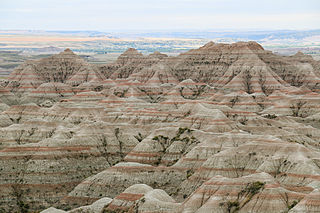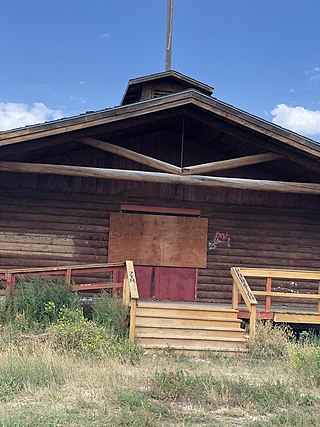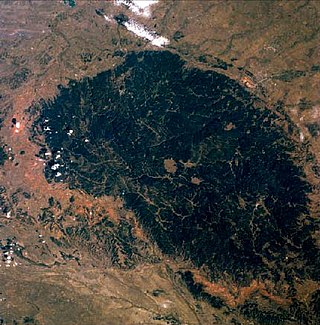Related Research Articles

The Crow, whose autonym is Apsáalooke, also spelled Absaroka, are Native Americans living primarily in southern Montana. Today, the Crow people have a federally recognized tribe, the Crow Tribe of Montana, with an Indian reservation located in the south-central part of the state.

The Sioux or Oceti Sakowin are groups of Native American tribes and First Nations peoples in North America. The modern Sioux consist of two major divisions based on language divisions: the Dakota and Lakota; collectively they are known as the Očhéthi Šakówiŋ. The term "Sioux" is an exonym created from a French transcription of the Ojibwe term "Nadouessioux", and can refer to any ethnic group within the Great Sioux Nation or to any of the nation's many language dialects.

Badlands National Park is an American national park located in southwestern South Dakota. The park protects 242,756 acres of sharply eroded buttes and pinnacles, along with the largest undisturbed mixed grass prairie in the United States. The National Park Service manages the park, with the South Unit being co-managed with the Oglala Lakota tribe.

Red Cloud was a leader of the Oglala Lakota from 1868 to 1909. He was one of the most capable Native American opponents whom the United States Army faced in the western territories. He defeated the United States during Red Cloud's War, which was a fight over control of the Powder River Country in northeastern Wyoming and southern Montana. The largest action of the war was the Fetterman Fight, with 81 US soldiers killed; it was the worst military defeat suffered by the US Army on the Great Plains until the Battle of the Little Bighorn 10 years later.

The Pine Ridge Indian Reservation, also called Pine Ridge Agency, is an Oglala Lakota Indian reservation located almost entirely within the U.S. state of South Dakota, with a small portion in Nebraska. Originally included within the territory of the Great Sioux Reservation, Pine Ridge was created by the Act of March 2, 1889, 25 Stat. 888. in the southwest corner of South Dakota on the Nebraska border. Today it consists of 3,468.85 sq mi (8,984 km2) of land area and is one of the largest reservations in the United States.

Red Cloud's War was an armed conflict between an alliance of the Lakota, Northern Cheyenne, and Northern Arapaho peoples against the United States and the Crow Nation that took place in the Wyoming and Montana territories from 1866 to 1868. The war was fought over control of the western Powder River Country in present north-central Wyoming.

Arikara, also known as Sahnish, Arikaree, Ree, or Hundi, are a tribe of Native Americans in North Dakota. Today, they are enrolled with the Mandan and the Hidatsa as the federally recognized tribe known as the Mandan, Hidatsa, and Arikara Nation.

The Oglala National Grassland is a United States National Grassland in the northwest corner of Nebraska. It is in northern Sioux and northwestern Dawes counties, on the borders with South Dakota and Wyoming. It is 94,520 acres (38,250 ha) in size and is one of the small handful of National Grasslands administered by the US Department of Agriculture's Forest Service. It is managed by the U.S. Forest Service together with the Nebraska and Samuel R. McKelvie National Forests and the Buffalo Gap and Fort Pierre National Grasslands from common offices in Chadron, Nebraska.

The Institute of American Indian Arts (IAIA) is a public tribal land-grant college in Santa Fe, New Mexico. The college focuses on Native American art. It operates the Museum of Contemporary Native Arts (MoCNA), which is housed in the historic Santa Fe Federal Building, a landmark Pueblo Revival building listed on the National Register of Historic Places as Federal Building. The museum houses the National Collection of Contemporary Indian Art, with more than 7,000 items.
The MacArthur Fellows Program, also known as the MacArthur Fellowship and commonly but unofficially known as the "Genius Grant", is a prize awarded annually by the John D. and Catherine T. MacArthur Foundation typically to between 20 and 30 individuals, working in any field, who have shown "extraordinary originality and dedication in their creative pursuits and a marked capacity for self-direction" and are citizens or residents of the United States.

The Wounded Knee Occupation, also known as Second Wounded Knee, began on February 27, 1973, when approximately 200 Oglala Lakota and followers of the American Indian Movement (AIM) seized and occupied the town of Wounded Knee, South Dakota, United States, on the Pine Ridge Indian Reservation. The protest followed the failure of an effort of the Oglala Sioux Civil Rights Organization (OSCRO) to use impeachment to remove tribal president Richard Wilson, whom they accused of corruption and abuse of opponents. Additionally, protesters criticized the United States government's failure to fulfill treaties with Native American people and demanded the reopening of treaty negotiations to hopefully arrive at fair and equitable treatment of Native Americans.

The Oglala are one of the seven subtribes of the Lakota people who, along with the Dakota, make up the Očhéthi Šakówiŋ. A majority of the Oglala live on the Pine Ridge Indian Reservation in South Dakota, the eighth-largest Native American reservation in the United States.

The Great Sioux War of 1876, also known as the Black Hills War, was a series of battles and negotiations that occurred in 1876 and 1877 in an alliance of Lakota Sioux and Northern Cheyenne against the United States. The cause of the war was the desire of the US government to obtain ownership of the Black Hills. Gold had been discovered in the Black Hills, settlers began to encroach onto Native American lands, and the Sioux and the Cheyenne refused to cede ownership. Traditionally, American military and historians place the Lakota at the center of the story, especially because of their numbers, but some Native Americans believe the Cheyenne were the primary target of the American campaign.

The Black Hills land claim is an ongoing land dispute between Native Americans from the Sioux Nation and the United States government over the Black Hills mountain range in the US states of South Dakota and Wyoming. The land in question was pledged to the Sioux Nation in the Fort Laramie Treaty of April 29, 1868, but a few years later illegally seized and the treaty nullified in the Indian Appropriations Bill of 1876 without the tribe's consent. That bill "denied the Sioux all further appropriation and treaty-guaranteed annuities" until they gave up the Black Hills. A Supreme Court case was ruled in favor of the Sioux in 1980. The Sioux have outstanding issues with the ruling and have not collected the funds. As of 2011, the award was worth over $1 billion.

Bison hunting was an activity fundamental to the economy and society of the Plains Indians peoples who inhabited the vast grasslands on the Interior Plains of North America, prior to the animal's near-extinction in the late 19th century following US expansion into the West. Bison hunting was an important spiritual practice and source of material for these groups, especially after the European introduction of the horse in the 16th through 18th centuries enabled new hunting techniques. The species' dramatic decline was the result of habitat loss due to the expansion of ranching and farming in western North America, industrial-scale hunting practiced by non-Indigenous hunters, increased Indigenous hunting pressure due to non-Indigenous demand for bison hides and meat, and cases of deliberate policy by settler governments to destroy the food source of the Indigenous peoples during times of conflict.
Arthur Douglas Amiotte is an Oglala Lakota American painter, collage artist, educator, and author.

Jacob Alexander Lurie is an American mathematician who is a professor at the Institute for Advanced Study. Lurie is a 2014 MacArthur Fellow.
Cecilia Ann Conrad is the CEO of Lever for Change, emeritus professor of economics at Pomona College, and managing director of the John D. and Catherine T. MacArthur Foundation. She formerly served as the Associate Dean of Academic Affairs at Pomona College. She currently oversees the foundation's MacArthur Fellows and 100&Change programs. Her research focuses on the effects of race and gender on economic status.

Sean Sherman is an Oglala Lakota Sioux chef, cookbook author, forager, and promoter of indigenous cuisine. Sherman founded the indigenous food education business and caterer The Sioux Chef, as well as the nonprofit North American Traditional Indigenous Food Systems. He received a James Beard Foundation Leadership Award and his 2017 cookbook, The Sioux Chef's Indigenous Kitchen, won the 2018 James Beard Award for Best American Cookbook. In 2021 he opened a restaurant, Owamni, in Minneapolis, Minnesota that serves dishes using ingredients present in North America before European colonization. Owamni won the 2022 James Beard Foundation Award for Best New Restaurant.
The Intertribal Buffalo Council (ITBC), also known as the Intertribal Bison Cooperative, is a collection of 82 federally recognized tribes from 20 different states whose mission is to restore buffalo to Indian Country in order to preserve the historical, cultural, traditional, and spiritual relationships for future Native American generations.
References
- ↑ Teltsch, Kathleen (June 16, 1987). "MACARTHUR AWARDS OF $150,000 TO $375,000 GO TO 'OUTSTANDINGLY TALENTED' 32". B. The New York Times . p. 8. Archived from the original on November 7, 2017. Retrieved February 23, 2017– via The New York Times Archives.
- 1 2 Flynn, Anne-Gerard (September 27, 2019). "University of Massachusetts professor Ocean Vuong to receive $625K grant as MacArthur fellow". The Republican . Archived from the original on October 1, 2019. Retrieved September 26, 2020.
- 1 2 "Alumni Points of Pride 2002-03" (PDF). May 13, 2002. Archived from the original (PDF) on October 12, 2013.
- 1 2 "Wesley Charles Jacobs Jr. - MacArthur Fellows Program". MacArthur Foundation . July 1, 1987. Archived from the original on December 19, 2019. Retrieved September 26, 2020.
- ↑ "Board of Directors". Intertribal Bison Cooperative. Archived from the original on April 13, 2010.